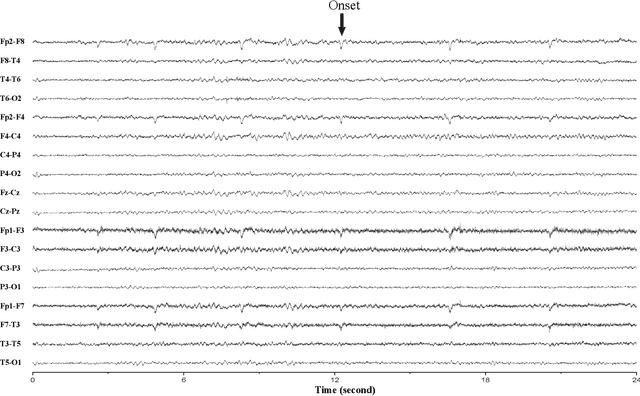Armin Nikpour
Prospective Identification of Ictal Electroencephalogram
Mar 03, 2021



Abstract:A vast majority of epileptic seizure (ictal) detection on electroencephalogram (EEG) data has been retrospective. Therefore, even though some may include many patients and extensive evaluation benchmarking, they all share a heavy reliance on labelled data. This is perhaps the most significant obstacle against the utility of seizure detection systems in clinical settings. In this paper, we present a prospective automatic ictal detection and labelling performed at the level of a human expert (arbiter) and reduces labelling time by more than an order of magnitude. Accurate seizure detection and labelling are still a time-consuming and cumbersome task in epilepsy monitoring units (EMUs) and epilepsy centres, particularly in countries with limited facilities and insufficiently trained human resources. This work implements a convolutional long short-term memory (ConvLSTM) network that is pre-trained and tested on Temple University Hospital (TUH) EEG corpus. It is then deployed prospectively at the Comprehensive Epilepsy Service at the Royal Prince Alfred Hospital (RPAH) in Sydney, Australia, testing nearly 14,590 hours of EEG data across nine years. Our system prospectively labelled RPAH epilepsy ward data and subsequently reviewed by two neurologists and three certified EEG specialists. Our clinical result shows the proposed method achieves a 92.19% detection rate for an average time of 7.62 mins per 24 hrs of recorded 18-channel EEG. A human expert usually requires about 2 hrs of reviewing and labelling per any 24 hrs of recorded EEG and is often assisted by a wide range of auxiliary data such as patient, carer, or nurse inputs. In this prospective analysis, we consider humans' role as an expert arbiter who confirms to reject each alarm raised by our system. We achieved an average of 56 false alarms per 24 hrs.
Epileptic Seizure Classification with Symmetric and Hybrid Bilinear Models
Jan 15, 2020



Abstract:Epilepsy affects nearly 1% of the global population, of which two thirds can be treated by anti-epileptic drugs and a much lower percentage by surgery. Diagnostic procedures for epilepsy and monitoring are highly specialized and labour-intensive. The accuracy of the diagnosis is also complicated by overlapping medical symptoms, varying levels of experience and inter-observer variability among clinical professions. This paper proposes a novel hybrid bilinear deep learning network with an application in the clinical procedures of epilepsy classification diagnosis, where the use of surface electroencephalogram (sEEG) and audiovisual monitoring is standard practice. Hybrid bilinear models based on two types of feature extractors, namely Convolutional Neural Networks (CNNs) and Recurrent Neural Networks (RNNs), are trained using Short-Time Fourier Transform (STFT) of one-second sEEG. In the proposed hybrid models, CNNs extract spatio-temporal patterns, while RNNs focus on the characteristics of temporal dynamics in relatively longer intervals given the same input data. Second-order features, based on interactions between these spatio-temporal features are further explored by bilinear pooling and used for epilepsy classification. Our proposed methods obtain an F1-score of 97.4% on the Temple University Hospital Seizure Corpus and 97.2% on the EPILEPSIAE dataset, comparing favourably to existing benchmarks for sEEG-based seizure type classification. The open-source implementation of this study is available at https://github.com/NeuroSyd/Epileptic-Seizure-Classification
 Add to Chrome
Add to Chrome Add to Firefox
Add to Firefox Add to Edge
Add to Edge